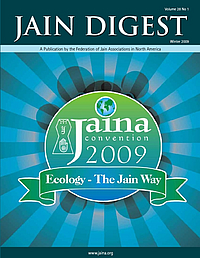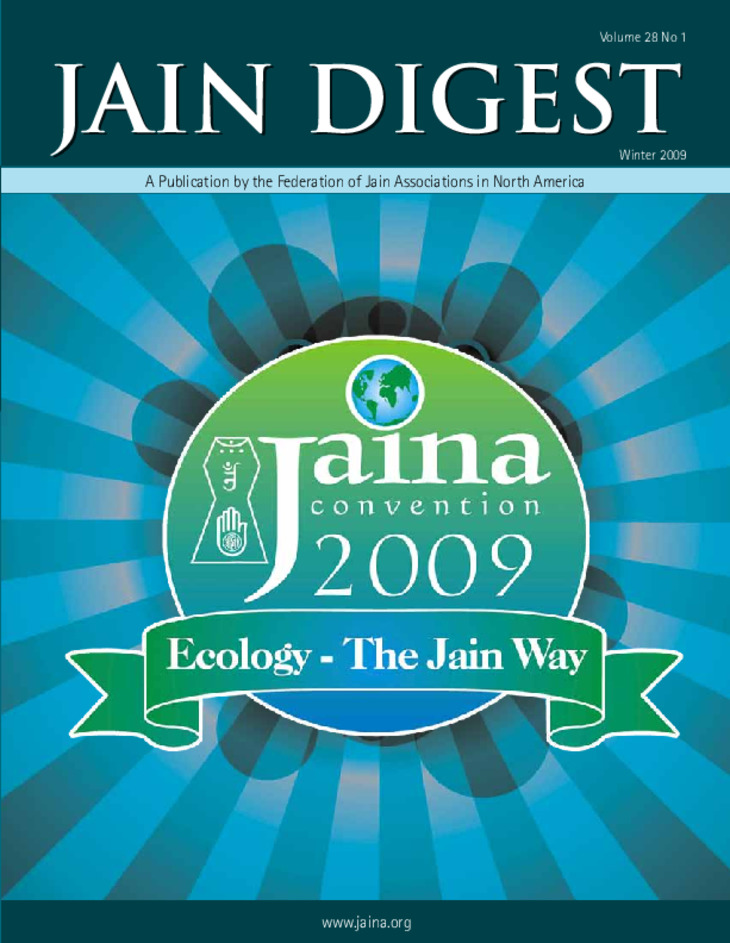
JAIN DIGEST 2009-1
 'Parasparopagraho Jivanam' is a maxim that is central to Jain doctrine and practice. For an English speaker, it can be a tongue-twister but its meaning is clear and simple: all living beings are inter-dependent. This idea underlies the ecological consciousness of Jainism.. It asks human beings to I reduce their unnecessary consumption and to form relationships of co-operation with the rest of the natural world rather than seeing nature as something 'other' to be exploited and subjugated.
'Parasparopagraho Jivanam' is a maxim that is central to Jain doctrine and practice. For an English speaker, it can be a tongue-twister but its meaning is clear and simple: all living beings are inter-dependent. This idea underlies the ecological consciousness of Jainism.. It asks human beings to I reduce their unnecessary consumption and to form relationships of co-operation with the rest of the natural world rather than seeing nature as something 'other' to be exploited and subjugated.
Ahimsa (non-violence) and Aparigraha (non-possessiveness) are about recognition of life's rich diversity, the intrinsic value of all life and that all living systems are intimately, often subtly linked. Jain philosophy has always extended the concepts of 'rights' and 'civil society' so that they include other species and ecosystems. Human intelligence, however, does not confer the right to conquer or control, but gives us responsibilities to act with compassion and restraint.
This ecological aspect of Jainism is increasingly well-known in the west, where it is given a new relevance by concerns over human-made pollution and climate change, results of an unbalanced relationship between humanity and 'the rest' of nature. Yet Jain principles are equally applicable to relationships between human beings and the way society is organised. Human society is, after all, an ecosystem in its own right. Social Cohesion: A Jain Perspective shows how insights gleaned from the Jain dharma have relevance to a pluralistic, secularised society such as Britain, where both authors live and work.
The principle of Anekant, or respect for alternative viewpoints, is well-designed for life in a pluralist democracy where there is no monopoly of truth. If more widely understood, it could give an underlying coherence to the multi-cultural society, so that both shared values and distinctive cultures can be promoted and respected. Anekant can also be a countervailing force against religious or political extremism, themselves products of social fragmentation.
This starting point for this monograph is that pluralism and individual freedom are sources of creativity and innovation - an idea that Jains strongly affirm. But in the absence of a coherent philosophical vision, they can have a darker side. Family breakdown, violence (including domestic violence), substance abuse, extremism and growing inequality are all symptoms of a malaise that is as much spiritual and ecological as economic or political. They are examples of unbalanced human relationships and false priorities.
Social Cohesion uses ideas derived from Jainism to point towards ways in which citizens and communities can work more co-operatively together, with greater trust re-established between people and government. It asks policy-makers to make connections between areas of life that do not automatically seem connected. The adversarial political system is in need of reform, for example, because it does not effectively meet the needs of a complex society where there are many shades of opinion and few 'black-and-white' issues. Rather than preserving stability, it now encourages aggression and confrontation. There is therefore a connection between constitutional reform and social cohesion. Likewise, inhumane urban architecture creates an atmosphere of isolation and alienation that is connected to family breakdown, addiction and violence. Here, there is a link between environmental policy, family policy and crime prevention.
The paper shows policy-makers how to transform vicious circles into virtuous circles. Beyond the specific proposals it makes, it calls for a change in the way we approach social issues, whatever our political ideology. Using the Jain principle of Careful Action, it invites all of us think about each action, individual or collective. Instead of imposing our worldviews on others, we should ask questions such as: 'what effect will it have a generation or more from now?'
 Aidan Rankin
Aidan Rankin
